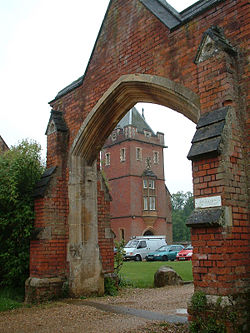Bulstrode Park: Difference between revisions
Created page with "{{Infobox house |name=Bulstrode Park |county=Buckinghamshire |picture=Bulstrode arch.jpg |picture caption=Bulstrode courtyard arch and north tower |os grid ref=SU985885 |latit..." |
|||
| Line 33: | Line 33: | ||
In 1966, the community moved to Kent, and the property was bought by WEC International, a Christian evangelical mission agency, who are gradually restoring and improving the public parts of the house's interior.<ref>{{cite journal|last=Stewart and Jean|first=Moulds|title=Recruitment, Renewal and Redevelopment|journal=WEC Worldwide magazine|date=May–June 2004|volume=528|pages=3}}</ref> | In 1966, the community moved to Kent, and the property was bought by WEC International, a Christian evangelical mission agency, who are gradually restoring and improving the public parts of the house's interior.<ref>{{cite journal|last=Stewart and Jean|first=Moulds|title=Recruitment, Renewal and Redevelopment|journal=WEC Worldwide magazine|date=May–June 2004|volume=528|pages=3}}</ref> | ||
The history of the house and a Guide to the gardens are available from the house's reception or bookshop in a publication called 'Bulstrode, the home of WEC International'. Bulstrode is open to the public one weekend in May or June every year, but visits to the grounds can be organized by prior arrangement with WEC International | The history of the house and a Guide to the gardens are available from the house's reception or bookshop in a publication called 'Bulstrode, the home of WEC International'. Bulstrode is open to the public one weekend in May or June every year, but visits to the grounds can be organized by prior arrangement with WEC International. | ||
==Outside links== | ==Outside links== | ||
Latest revision as of 22:00, 11 September 2015
| Bulstrode Park | |
| Buckinghamshire | |
|---|---|
 Bulstrode courtyard arch and north tower | |
| Location | |
| Grid reference: | SU985885 |
| Location: | 51°35’12"N, -0°34’47"W |
| History | |
| Country house | |
| Information | |
| Owned by: | WEC International |
Bulstrode is a mansion with its extensive surrounding parkland to the northwest of the Buckinghamshire town of Gerrard's Cross. The estate predates the Norman conquest and the name may originate from the Old English burh strod meaning 'fort marsh'.
First house
The previous house was built in 1686 for the infamous Judge Jeffreys, a prominent enforcer for King James II. After James II fled and Jeffreys died in the Tower, the estate was sold to Hans William Bentinck, a friend and courtier of William of Orange who helped establish William as king. Bentinck made Bulstrode one of his principal residences. He died there in 1709. In the 1740s, the architect and builder Stiff Leadbetter altered the house significantly for the 2nd Duke of Portland. Between 1806-1809, there were further re-modellings and additions, including the castellated West Wing, to the designs of James Wyatt for the 3rd Duke.

Bulstrode was used by Margaret Bentinck, the wife of the 2nd Duke to house her natural history and antiquities collection, with the south-west side of the park used for live specimens (called Menagerie Wood today). The botanists Joseph Banks and Daniel Solander donated to the Dowager many exotic plants to develop the gardens at Bulstrode, which became the inspiration for Mrs Mary Delany's floral “paper mosaicks” now held in the British Museum Library which were greatly admired by Queen Charlotte.[1] The grounds today are grade 1 listed.
Their son, the 3rd Duke was a collector of marble and glass, and was influential in loaning the Roman Portland Vase to Josiah Wedgwood. When the 4th Duke of Portland inherited the title in 1809, he disposed of Bulstrode. The title then passed into the hands of the Dukes of Somerset.
Present house
The 12th Duke of Somerset, Edward Adolphus Seymour commissioned the present mansion, completed in 1865. After his death, it passed to his daughter, Lady Helen Guendolen Ramsden and then to her son, Sir John Frecheville Ramsden, until he lost his fortune.
In 1932, the estate was sold. Outlying buildings were sold, but the house was unoccupied until Second World War, when it was used for training by the WAAF Women's Auxiliary Air Force.
After the War, Sir John used part of the property for chemical research into sisal by-products, but the property fell into disrepair.
After his death in 1958, the park was sold to a farmer, and the mansion and woodland were bought by the Bruderhof community, who support themselves with light industry.
In 1966, the community moved to Kent, and the property was bought by WEC International, a Christian evangelical mission agency, who are gradually restoring and improving the public parts of the house's interior.[2]
The history of the house and a Guide to the gardens are available from the house's reception or bookshop in a publication called 'Bulstrode, the home of WEC International'. Bulstrode is open to the public one weekend in May or June every year, but visits to the grounds can be organized by prior arrangement with WEC International.
Outside links
| ("Wikimedia Commons" has material about Bulstrode Park) |
- Bulstrode Park entry from The DiCamillo Companion to British & Irish Country Houses
- Further details of current owners (WEC International)
